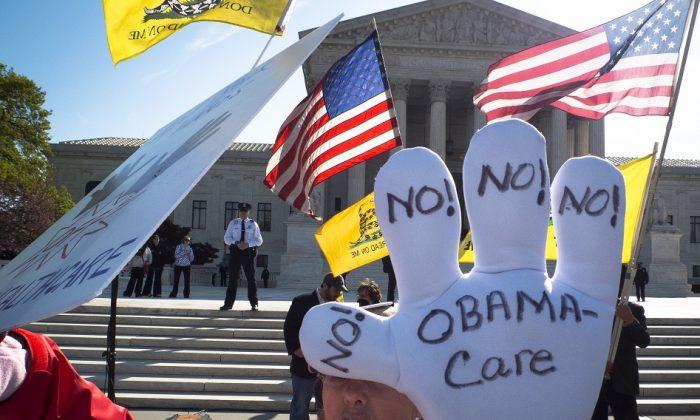Legislators in the Minnesota Senate presented a bill written to restore the doctor-patient relationship corroded by the socialization of medicine, the hazards of which were brought into focus with the COVID-19 pandemic.
“During COVID, people gave up a lot of freedom,” state Sen. Jim Abeler told The Epoch Times.
The freedom to assemble, to go to church, to remain unvaccinated, and to choose one’s own health care, were all forfeited under the guise of “helping their fellow man,” Abeler said.
“This is very concerning to me,” Abeler said. “The bill is an effort to maybe unwind some of that.”

Brase told The Epoch Times that though the restrictive hospital protocols enacted during the pandemic brought the issue to light, the problem has existed for much longer.
The Emergency of the Health Maintenance Organization
Brase details where this process began in her 2001 article, “Blame Congress for HMOs.” She charts how—after the 1965 enactment of Medicare and Medicaid—“literally overnight, on July 1, 1966, millions of Americans lost all financial responsibility for their health decisions.”According to Brase, the propagation of HMOs (health maintenance organizations), stemmed from a financial crisis caused by the launch of Medicare and Medicaid.
“Offering ‘free care’ led to predictable results,” Brase writes in her article. “Because Congress placed no restrictions on benefits and removed all sense of cost-consciousness, health-care use and medical costs skyrocketed.”
Those in favor of universal coverage used the financial crisis to advocate for HMOs, which Brase called “a more corporate version of socialized medicine under which individual control over health care decisions was weakened.”
“The HMO system was a step closer to a national health care system,” Brase said, “or what the public would decades later often call the Affordable Care Act of 2010, which mandated health plans—the new name for the HMO—for almost everyone.”
The intent behind the HMO Act—signed into law by President Richard Nixon on December 29, 1973—was to merge the delivery and financing of care into one entity, which Brase said creates a conflict of interest.
“There is now an interest in decreasing the amount of care to the patient so that the entity can keep more money for itself,” Brase said.
As patients have since discovered, Brase said in her article, the HMO “was not much of a Christmas present or an insurance product,” adding that though it promised coverage, it frequently denied access.
As a result of public anger with HMOs, Congress introduced the Patients’ Bill of Rights Act of 1998.
Though it never became law, the terminology began to change. Instead of HMO, the term “health plan” emerged, Brase said.
Hospitals Turned Conglomerates Overseen by Hospitalists
President Barack Obama’s Affordable Care Act (ACA) mandated everyone to have a qualified health plan, she explained.The ACA also created Accountable Care Organizations, as part of the new “Medicare Shared Savings Program,” which she said essentially turns the hospital into a conglomerate that’s in conflict of interest with patients.
“The hospital has become like an umbrella and under it are either the contracted, owned, or employed physicians and clinics,” Brase said. “By virtue of that, if the whole conglomerate can save the government money, [the Accountable Care Organization] can get part of the savings back from the government, which tends to go to the hospital.”
The hospitals began to hire hospitalists and tell physicians—particularly family practice doctors and internists—they couldn’t admit patients or direct patient care at the hospital, Brase said.
“Hospitalists are typically the only ones allowed to make a majority of the decisions about what happens in the hospital because that will allow the hospital to save money and gain a share of those savings back,“ Brase said. ”Ultimately these doctors work for the hospital, their employer, not the patient.”
Likely as a result of the ACA’s shared saving program, many hospitalists around the country have canceled hospital privileges for independent doctors—those who are not employed by the hospital—thus eliminating the doctor’s right to take care of their patients who’ve been hospitalized, she said.
Many hospitalized patients might have been saved during the pandemic if they had been allowed to choose their own doctor, Brase said.
Patients often requested physicians who were willing to treat outside of the government standard-of-care box by prescribing early treatment drugs like ivermectin and hydroxychloroquine, as opposed to pushing late-treatment drugs like remdesivir and mechanical ventilation that too often led to organ failure and death.
Their requests were often denied, Brase said.
“If this bill were law, it would give patients that freedom to request their own doctor, and it would require the hospital to allow them to come and direct the patient’s care without hospital privileges being required,” she said.

The Electronic Health Record
For too long, health care has been leveraged based on what the hospital is willing to pay for and using only protocols allowed by the electronic health record (EHR).“The whole move here is to use the electronic health record as what controls everything that happens in the hospital,” she said.
In addition, the EHRs have led to burnout resulting from the “cognitive burden” of the endless clicking and searching that eats into the time the doctor could be spending with the patient.
A Solution: The Wedge of Health Freedom
In 2016, Brase launched The Wedge of Health Freedom to provide a “zone of deregulation” for health care providers who wish to escape the business and return to practicing medicine.Doctors, clinics, surgical centers, dentists, and other health care facilities that wish to join the network engage in a “voluntary collaborative venture” between third-party free practices—who have no insurance or government contracts—and the Citizens’ Council for Health and Freedom.
“We just added more than 20 practices in the last week from all over the country, so that’s exciting for us,” Brase said.
The intent of moving toward this new framework is to “resurrect the private practice,” Brase said.
Instead of going to a doctor who will follow a standardized protocol automated by the EHR, patients need doctors who will treat them as individuals.
“Doctors need their freedom to practice and use their own critical thinking to come up with ideas that might not even be protocol yet,” Brase said.
Brase said most patients don’t realize how difficult it has been for health care workers who have reported to her feeling as if they’ve been put on a dehumanizing conveyer belt while striving to navigate through the labyrinth of paperwork just to treat a patient.
“If patients realized how bad it was for the doctors, they’d realize how bad it was for them,” Brase said, “because whatever happens to the doctors will define what happens to the patient.”





